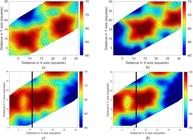Abstract
This work presents improvements to a telecommunication service planning tool for optimal positioning of base stations presented in a previous work. The tool uses a propagation loss model based on the K-Nearest Neighborhoods classifier since its conception. The original objective of this tool is to optimize the positioning of transmitting towers in the frequencies of 2.1 GHz and 2.6 GHz in a given environment, maximizing the coverage area. The improvement proposed in this article includes the optimization of the positioning of the towers in order to meet the maximum coverage, prioritizing the locations considered most important. The studied scenario is the campus of the Federal University of Pará, with characteristics similar to some cities in the Amazon region. The analysis of the results was made by comparing the power data received from the measurement campaigns with the coverage estimates obtained with the improved tool. The improved methodology showed better results than those from the previous study, both in the positioning of the antennas and in the time spent. We obtained a reduction of up to 72% in the time to calculate the optimal solution compared to the original study.
Index Terms
Optimization; Radiopropagation Models; Radio Base Station; Telecommunications

 Thumbnail
Thumbnail
 Thumbnail
Thumbnail
 Thumbnail
Thumbnail
 Thumbnail
Thumbnail
 Thumbnail
Thumbnail
 Thumbnail
Thumbnail





